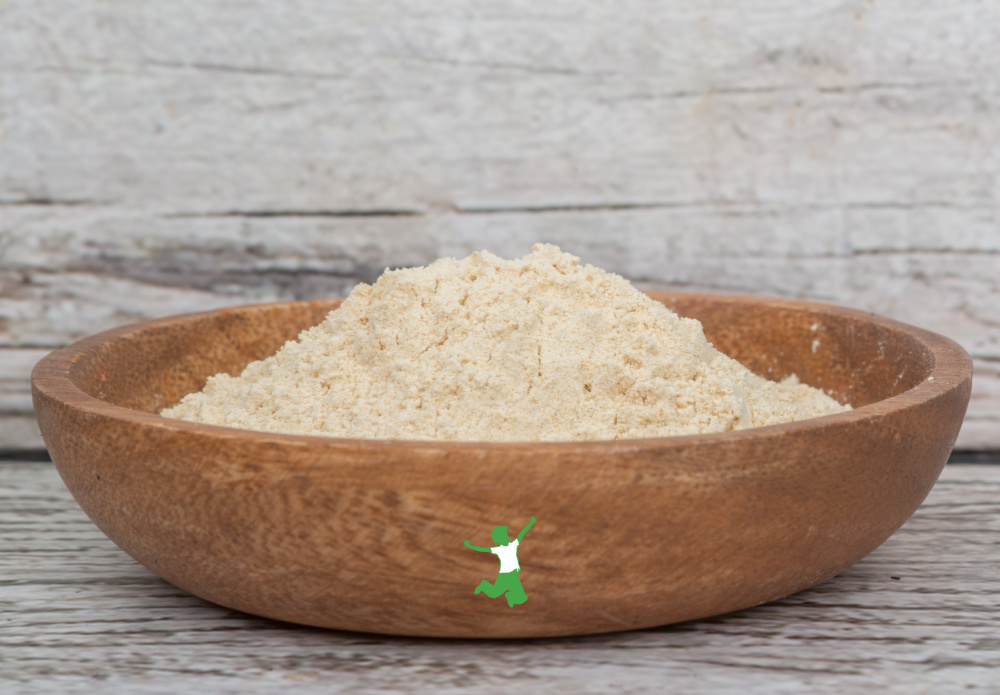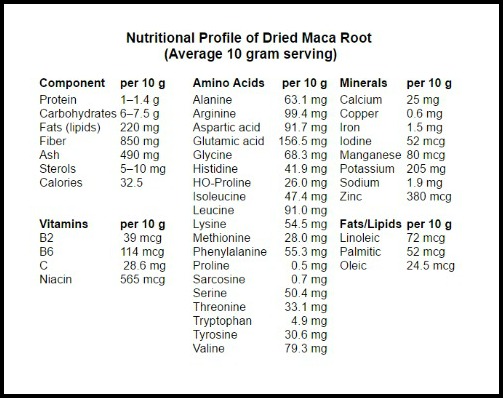Examination of the ancestral uses of maca and scientific research of its benefits (and contraindications) for hormone balance and overall health.

Almost any time an ancient superfood is discovered in some far flung part of the world, high atop a mountain or in some hidden valley or vale, soon the media will be abuzz with all the benefits which always seem to border on the magical. Maca is no exception!
Maca: Peruvian Superfood
If you love cooked or raw crucifers or have a special affection for kale smoothies you will probably already be inclined to like maca (Lepidium meyenii).
A cruciferous vegetable in the mustard family, maca root is similar to turnips and radishes.
Unlike all these other veggies, however, maca’s claim to fame is the very narrow place it is natively found – the Andes mountains in and around Peru.
The root of the maca plant comes in a variety of colors, most commonly red, black, and yellow, with many shades as well, such as green, purple, and white.
The darker colored maca roots contain significant amounts of iodine.
Thus, the root ironically has been traditionally valued for starving off and treating goiter, that the lighter colored maca, like its cruciferous cousins, can cause.
Traditionally, the plant was cultivated and then harvested.
The roots were dried in the sun, then crushed into powder. Many modern maca powders are still created using these same traditional techniques. (1)
Maca’s Magnificence
What makes Maca special? For one thing, it has a pretty solid nutritional profile.
The nutritional value of dried maca root is high, resembling those of cereal grains such as maize, rice, and wheat. It contains 60-75% carbohydrates, 10-14% protein, 8.5% fiber, and 2.2% lipids. The protein content of maca exists mainly in the form of polypeptides and amino acids (including significant amounts of arginine, serine, histidine, aspartic acid, glutamic acid, glycine, valine, phenylalanine, tyrosine, and threonine). It also has about 250 mg of calcium, 2 g of potassium, and 15 mg of iron in 100 g of dried root-and important amounts of fatty acids (including linolenic, palmitic, and oleic acids). Maca contains sterols (about 0.05% to 0.1%) and other vitamins and minerals. (2)
As the above shows, dried maca root is high in potassium, like lentils.
It is also known for its high copper content (around 85% of the recommended daily allowance).
It contains a wide variety of other plant chemicals with known health benefits, such as glucosinolates and polyphenols.
Here is a chart of the complete nutritional profile of maca root: (3)

Health Benefits
A number of well-crafted studies attest to the health benefits of consuming maca, especially as maca root powder. It has passed all those studies with positive results.
The only problem with the studies has been small sample sizes and limited durations.
So while the science is so far promising, maca is definitely a food that could use more long-term research and attention to validate its value.
Let’s look at a sampling of what nine of these studies suggest about maca benefits.
For Women
Maca has been shown to help with certain symptoms of menopause.
It appears that maca helps tame the menopausal beast most prominently experienced as hot flashes for some women. (4)
It also appears to help older women dealing with depression. In addition, maca has value in protecting against and preventing depression in the first place. (5)
For Men
If a man is struggling with sexual drive or conception, maca shows some promise.
Maca has been shown to increase sperm counts and motility, along with improving sexual desire in young and middle-aged men. (6, 7)
Interestingly, it appears maca does this without increasing testosterone levels, like some other male supplements. (8)
It has also been shown to help decrease prostate size, a problem that is more prevalent in older men. (9)
This may, over time, translate into reduced prostate cancer risk, but this leap based on current research is currently premature.
Maca for Everyone?
Maca has demonstrated promising, though mild results in improving our ability to handle stress along with improving athletic performance. (10)
Extract of maca was shown to help protect against UV damage from the sun when applied directly to the skin. (11)
It has also been shown to help improve memory and learning. However, it appears the black maca variety shows the most promise in this area. (12)
We could list many more studies and various suspected benefits, but these 9 studies provide a comprehensive overview.
In summary, maca in the scientific literature shows promising results. But, as Mark Blumenthal, executive director of the American Botanical Council, aptly pointed out, the short duration and small sample sizes of the studies suggest that:
The science on maca’s potential benefits is so far suggestive but not conclusive. (13)
Moringa vs Maca Powder
Maca powder is frequently confused with moringa powder (Moringa oleifera).
Both are touted and marketed as energy boosters and hormone balancers. They also both look similar in powder form.
One big difference is that moringa powder comes from the leaves or seeds of the moringa tree, while maca powder comes from the root.
In addition, moringa is native to Southeast Asia, while maca is a Peruvian superfood.
Both of these plants are, at the current time, unhybridized and were considered nutrient-dense superfoods by ancestral cultures.
Moringa is an ancient remedy within Ayurvedic medicine and has an excellent history of use.
Is Maca a Thyroid Risk?
One word of warning concerning maca.
Maca belongs to the Brassicaceae family, which includes cruciferous vegetables like broccoli and kale.
Compared to other cruciferous plants, maca contains lower levels of glucosinolates, the compounds responsible for goitrogenic (thyroid-suppressing) effects.
However, those with thyroid issues would probably be wise to avoid maca despite the research suggesting its benefits for hormones.
Choose moringa instead (fresh is best)!
Maca Root What If ….
What if the reason so many of these so-called superfoods are healthful isn’t because they are magical, but because they are normal.
By normal, I mean mostly unhybridized, untampered with, untamed foods.
Wild foods.
Foraged foods.
Call them what you will, foods with high nutrient levels are going to be superfoods when compared to the depleted, over-hybridized, GMO, soil-depleted, and over-farmed varieties we are all used to consuming from the common grocery and even healthfood store!
The problems with the modern food supply are many.
One of the biggest issues that even traditional foodies frequently don’t seem to grasp is the significant loss of mainline nutrients…minerals, vitamins, protein, and the like…from our food.
This, combined with the loss of other types of beneficial compounds and phytonutrients over the past few hundred years, has proven nothing short of devastating to human health.
The push for more, bigger, better, faster may have made our food supply cheaper, but it came at an incredibly high price.
Think of that the next time you are walking the aisles of Whole Foods, Sprouts, Trader Joe’s, Costco or Super Wal-Mart.
While we may be spending our dollars on foods that contain fewer additives and chemicals, are they really any more nutritious?
Probably not, which is why eating organic alone will not make you well.
Not getting poisoned does not equate to being nourished!
How Much Maca Powder to Take?
Most of the maca studies used a dosage of around 1500 mg to 5000 mg per day (most likely as maca capsules).
This equates to about 3-6 teaspoons per day for loose powder.
The powder is typically stirred into beverages or blended into smoothies for a superfood boost.
Remember that the color of maca root matters.
Most store-bought maca supplements use the yellow root, but other colors, especially red and black maca, have different properties and value.
You may wish to try them all to see which produces the best results for your particular health situation.
This unique product is a blend of a variety of maca root skin colors—over 20 types, organically grown at high altitudes in Peru and sourced directly from local growers.
How Does Maca Taste?
Maca smells sweet, a bit like coconut sugar.
The taste, however, is quite strong and unpleasant to some.
Hence, mixing it into smoothies or other foods with masking flavors is a good idea.
The strong taste is another reason some prefer to take it in capsule form.
Start Small
As with any supplement, it is generally recommended to start with a small amount for a few days. Then, increase gradually provided no adverse reactions or other problems occur.
Maca is considered an adaptogen.
This means that the body can get “used” to it over time, which may lessen its beneficial effects.
As such, it is commonly suggested not to use it constantly over a long period of time.
Instead, some suggest using it in a cycle with other such supplements.
For example, 6 weeks on, 2 weeks off.
Contraindications
As mentioned earlier in this article, maca is a goitrogenic food (like millet and soy) even though darker colored maca is high in natural iodine, which helps offset the effects.
Hence, people with thyroid and similar issues may want to steer clear or only take it under the care of a health professional.
Thyroid problems and adrenal issues often go hand in hand. To be on the safe side, anyone experiencing adrenal fatigue symptoms should consult with a professional before supplementing with maca too.
If you are going to use maca to treat more serious health problems, it may be best to seek out a practitioner with experience with maca as well as your particular condition(s).
Always be aware of possible drug and other interactions that any superfood supplement may create.
Be sure to start low and slow and remember that no superfood is a silver bullet.
Is Maca Worth the Money?
My answer is maybe to probably.
I would personally try more wild and unhybridized foods in my own region and food sheds first.
This approach would ascertain if what really helps people about maca is something that is already available locally and natively grown.
If I had specific conditions that maca may help with and remedies were not forthcoming via local foodways, I wouldn’t hesitate to try maca and see if its purported benefits proved helpful.

(1) Maca: Lepidium meyenii or Peruvian ginseng
(2, 3) The Tropical Plant Database
(4) University of Michigan Health: Maca
(5, 13) Maca: Can a Root Boost Energy and Sex Drive?
(6) Effect of two different extracts of red maca in male rats with testosterone-induced prostatic hyperplasia
(7) Dose-response effect of Red Maca (Lepidium meyenii) on benign prostatic hyperplasia induced by testosterone enanthate
(8) Antagonistic effect of Lepidium meyenii (red maca) on prostatic hyperplasia in adult mice
(9) Red maca (Lepidium meyenii) reduced prostate size in rats
(10) A pilot investigation into the effect of maca supplementation on physical activity and sexual desire in sportsmen
(11) Hypocotyls of Lepidium meyenii (maca), a plant of the Peruvian highlands, prevent ultraviolet A-, B-, and C-induced skin damage in rats
(12) Preservation of Cognitive Function by Lepidium meyenii (Maca) Is Associated with Improvement of Mitochondrial Activity and Upregulation of Autophagy-Related Proteins in Middle-Aged Mouse Cortex








Geletanized seems to have no affect for me but I finally got raw powder and it definitely works
How do I get this maca product
The suggested brand is linked in the article above.
I’ve been using maca powder lately to deal with my receding hairlines. What is your take on this?
It might be helpful. Note that the type of fat in the diet is very important to prevent hair loss. https://www.thehealthyhomeeconomist.com/saturated-fat-prevents-hair-loss-balding/
I’ve been taking 2 teaspoons of maca powder lately to deal with receding hairlines, what is your take on this?